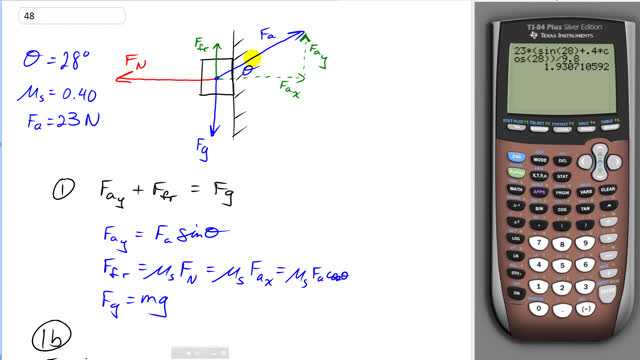
A small box is held in place against a rough vertical wall by someone pushing on it with a force directed upward at above the horizontal. The coefficients of static and kinetic friction between the box and wall are 0.40 and 0.30, respectively. The box slides down unless the applied force has magnitude 23 N. What is the mass of the box?

In order to watch this solution you need to have a subscription.
This is Giancoli Answers with Mr. Dychko. We need to find out what the mass of this box must be given that an applied force is at an angle of 28 degrees above the horizontal, and the coefficient of static friction his 0.4. The coefficient of kinetic friction is an irrelevant piece of information because we're told that the box is not moving when there's a force of 23 newtons, so, that means it's static friction, that's involved in non kinetic friction. So, the way I've drawn it here is to show all the forces involved. Upwards we have the static friction force and then we also have some component of the applied force that's also in the y direction upwards. And those two, this component here and this friction force, both being up, have to equal the total forces down which is only one, this gravity downwards. Since it's not moving, the total up has to equal the total down and because it's not moving we also know the total to the left has to equal total to the right. So, there is a component of the applied force in the x direction and that's going to equal the normal force which is to the left. So, we can say it with algebra now, we can say that the component of the applied force in the y direction plus the friction upwards, that total has to equal gravity down. And then we can create expressions for each of these terms and then rewrite this equation with some substitutions. So, we'll say that the component of the applied force in the y direction is the applied force, Fa, times sine theta because this is the opposite leg of this applied force triangle. And then we'll also say that the friction force is coefficient of static friction times the normal force. But the normal force equals the x component of the applied force since there's no movement horizontally, so, that means, or no acceleration horizontally and that means that this has to equal this, and so, we can make that substitution and the x component of the applied force is the applied force times cosine theta because it's the adjacent leg of this triangle. And then finally we'll say that force of gravity is mg. So, we'll substitute for each of these things. So, Fa y is Fa sine theta. And force of friction is muS times Fa cos theta. And then force of gravity is mg. So, we have this equation now here. And we'll solve this for the mass that the box must have by dividing both sides by g and switching the sides around. Then we have the mass must be 23 newtons applied force times sine 28 plus 0.4 times cos 28, all divided by 9.8 newtons per kilogram. And that gives 1.9 kilograms must be the box's mass.